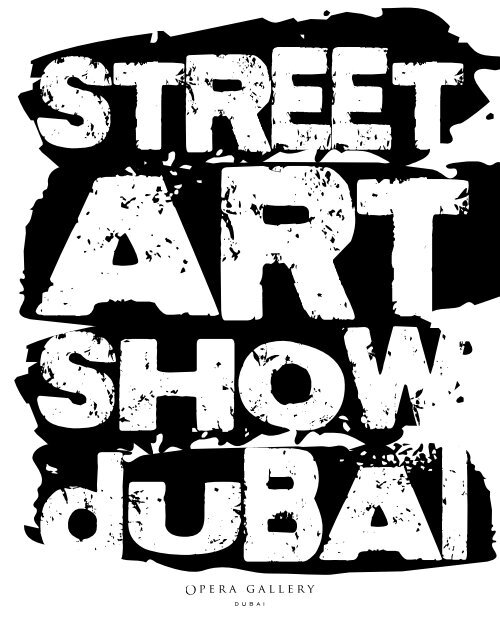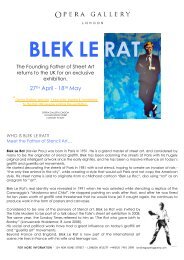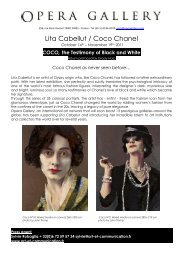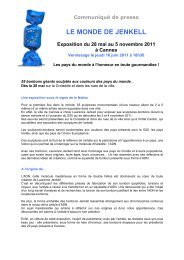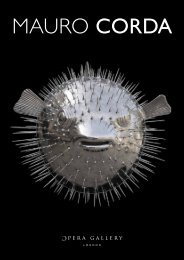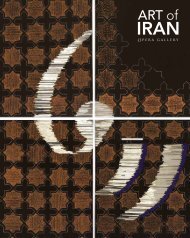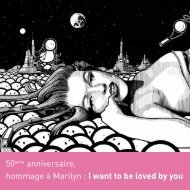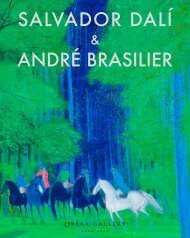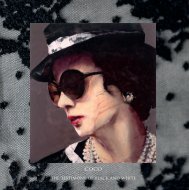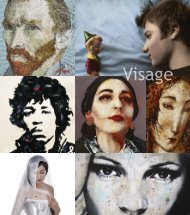Download catalogue - Opera Gallery
Download catalogue - Opera Gallery
Download catalogue - Opera Gallery
You also want an ePaper? Increase the reach of your titles
YUMPU automatically turns print PDFs into web optimized ePapers that Google loves.
From the ‘Godfather of Graffiti’ to the man behind explosive<br />
solo shows that gripped the U.S. from coast to coast, from an<br />
Iranian artist and active graphic designer to a French artist with<br />
strong ties to the international music scene, and not to forget<br />
the striking welder of metal mesh with traditional paint and<br />
canvas, <strong>Opera</strong> <strong>Gallery</strong> Dubai presents six major street artists:<br />
Seen, Mr. Brainwash, Blek le Rat, Mohammad Khodashenas,<br />
Charles Munka and Paul Alexis.<br />
Among the works by Seen, those in the Signatures series<br />
feature repetitions of the artist’s name on the canvas reiterated<br />
until it approaches abstraction; obscured along with Seen’s<br />
signature are the artist’s identity and, with a postmodern<br />
twist, the signifier behind the sign. Depictions of comic book<br />
superheroes (Iron Man head, Silver Surfer, Superman and<br />
Wolverine B&W) serve as references to the roots of pop art and<br />
its genesis in the 1950’s. These images’ cheerful colours and<br />
crisp lines present a world in which good and evil are easily<br />
distinguished, a welcome contrast to the blurred realities of<br />
postmodern life.<br />
Mr. Brainwash, too, often reproduces images of cultural icons,<br />
as in Mickey, Mickey and Minnie, Charlie Chaplin and Einstein.<br />
Motifs like Campbell soup cans (Max spray) recall Warhol,<br />
while maxims such as ‘Love is the Answer’ (Einstein) or ‘Life is<br />
Beautiful’, the title of his L.A. exhibition, imbue the works with<br />
a simplicity that is either endearing or ironic.<br />
Blek le Rat’s work tends not to draw on pop icons but rather<br />
classical icons. He also often depicts the everyday man or<br />
woman, as in the works in this exhibit. His paintings thus might<br />
be categorized as a type of portraiture honouring the common<br />
person, such as the young girl in Minor Sins 2. Blek encourages<br />
his audience to recognize those who might not otherwise be<br />
celebrated, as in Young Afro-american from San Francisco, or to<br />
appreciate those who enrich our lives like artists and musicians,<br />
as in Violonist. He speaks to viewers by mirroring them. The<br />
artist is also inspired by political events around the world. He<br />
uses his art to serve a social cause, to evoke reaction and inspire<br />
Gilles Dyan<br />
Founder and Chairman<br />
<strong>Opera</strong> <strong>Gallery</strong> Group<br />
changes, such as in his artwork In memoriam of<br />
conceptual art.<br />
Khodashenas creates works that are more overtly<br />
political: Che Guevara and revolution are common<br />
motifs (as in Che). The artist also draws on Iranian<br />
history. Who Killed Soraya, for example, refers<br />
to the mystery surrounding the death of Soraya, second wife<br />
to the last Shah - when the former Pahlavi Queen was found<br />
dead in her Paris apartment in 2001, some alleged murder.<br />
Khodashenas’ other paintings, such as Rolling Stone wall,<br />
combine Western pop culture with Persian script, reminding<br />
the viewer of the globalization that defines our times.<br />
In Munka’s canvases, ambiguously ancient characters render<br />
the compositions illegible while recognizable figures and<br />
motifs simultaneously lead the viewer into their fold. An image<br />
like Seven Hills recalls cave drawings, whereas the painting,<br />
Smoke Circles, imitates chalk drawings on black asphalt - literal<br />
‘street art’. The Snake more closely resembles conventional<br />
graffiti but in a deconstructed form, so that black lines overlay<br />
regions of bright colours rather than serve as strict outlines to<br />
well-defined letters and figures.<br />
And, yet, Alexis provides an alternative response to the pop<br />
culture figures recurrently referenced in street art. Layers of<br />
metal mesh placed atop images of famous faces, such as that<br />
of American pop idol, Madonna, or 20 th Century Egyptian<br />
goddess, Oum Kalsoum, render images that are hazy and<br />
impersonal. Alexis thus forces viewers to confront the paucity<br />
of collective culture and memory beyond its comfortable<br />
familiarity.<br />
These six artists work with many of the same materials,<br />
incorporating pop culture and referring to contemporary art,<br />
but ultimately each provides a distinct perspective from which to<br />
view modern-day life. Together, they create a dialogue: <strong>Opera</strong><br />
<strong>Gallery</strong> Dubai has the pleasure of inviting you to participate in<br />
this conversation.<br />
Mariam Thani Hodge<br />
General Manager<br />
<strong>Opera</strong> <strong>Gallery</strong> Dubai
The street artist, Seen, born Richard Mirando in 1961, hails from the<br />
Bronx, New York. Seen’s career began at just twelve, when he started<br />
painting New York subway cars, soon gaining a reputation with fellow<br />
taggers in the collective, United Artists, for covering whole cars.<br />
Rightfully called the ‘Godfather of Graffiti’, Seen has continued to<br />
exhibit his creativity ever since. He persevered in tagging on the<br />
New York subway in the 1980’s, even after the Metropolitan Transit<br />
Authority had successfully pressured many other artists to stop. Early<br />
that decade, Seen had begun to produce works on canvas that were<br />
purchased and displayed internationally. Entering both museum and<br />
private collections, Seen’s artwork was displayed alongside that of art<br />
icons such as Jean-Michel Basquiat, Keith Haring and Andy Warhol<br />
(‘New York, New Wave’ in 1981). Seen helped transform street art into<br />
an art genre recognized by the mainstream.<br />
Active for over four decades, Seen has not only changed the way we<br />
see street art, but also helped shape our definitions of art at large - he<br />
has imprinted his signature on the streets we walk as well as the world<br />
of contemporary art.<br />
Iron Man head<br />
Stencil and aerosol on canvas<br />
215 x 100 cm - 84.6 x 39.4 in.<br />
03
Superman<br />
Stencil and aerosol on canvas<br />
220 x 255 cm - 86.6 x 100.4 in.<br />
Signatures<br />
Aerosol on canvas<br />
220 x 220 cm - 86.6 x 86.6 in.<br />
04<br />
05
Wolverine B&W<br />
Aerosol on canvas<br />
180 x 150 cm - 70.9 x 59.1 in.<br />
Silver Surfer<br />
Aerosol on canvas<br />
162 x 130 cm - 63.8 x 51.2 in.<br />
06<br />
07
Among the well-recognized street artists<br />
today is Mr. Brainwash (born in 1966), whose<br />
appellation serves as the pseudonym of Thierry<br />
Guetta. A French artist and film maker who now<br />
lives and works in Los Angeles, Mr. Brainwash<br />
has unveiled several memorable projects in<br />
recent years.<br />
In 2008, his L.A. solo exhibit, ‘Life is Beautiful’,<br />
combined images with installation; the show’s<br />
duration was extended from two weeks to three<br />
months due to popular demand, with thousands<br />
of visitors coming to appreciate Mr. Brainwash’s<br />
work. Two years later, in 2010, Mr. Brainwash<br />
opened his expansive solo exhibit, ‘Icons’, in<br />
New York. The exhibit was closely followed by<br />
‘Icons Remix’ that same year, which also featured<br />
mixed-media paintings and sculptures. Finally,<br />
2010 served as the release of the documentary,<br />
‘Exit Through the Gift Ship’, for which Mr.<br />
Brainwash collaborated with world-famous<br />
graffiti artists Bansky and Shepard Fairey. The<br />
film was celebrated by critics and fans alike.<br />
As can be seen in <strong>Opera</strong> <strong>Gallery</strong>’s current show,<br />
Mr. Brainwash’s canvases often reproduce<br />
images from pop culture; he incorporates a<br />
variety of techniques including stenciling to do<br />
so.<br />
Max spray<br />
Stencil and mixed media on canvas<br />
101,5 x 233,5 cm - 40 x 92 in.<br />
09
Mickey<br />
Stencil and mixed media on canvas<br />
91,5 x 91,5 cm - 36 x 36 in.<br />
Charlie Chaplin<br />
Stencil and mixed media on canvas<br />
162,5 x 122 cm - 64 x 48 in.<br />
10
Mickey and Minnie<br />
Stencil and mixed media on canvas<br />
162,5 x 122 cm - 64 x 48 in.<br />
Einstein<br />
Stencil and mixed media on canvas<br />
162,5 x 122 cm - 64 x 48 in.<br />
12<br />
13
Blek le Rat, the assumed name of Xavier Prou, was born in 1952 in<br />
Paris. Widely considered the father of stencil graffiti, Blek le Rat began<br />
his career by stencilling rats on the streets of Paris in the early 1980’s.<br />
Blek had initially been inspired by graffiti art in New York, but he soon<br />
served to establish a parallel French street art scene. His use of the<br />
stencil was a way of adapting American graffiti art to French culture by<br />
invoking its Latin roots.<br />
Blek le Rat focuses on the figure more so than many other graffiti artists,<br />
with very little text appearing in his works. He stencils detailed images<br />
of common people as well as classical figures - including depictions<br />
of Greco-Roman statues or historical icons such as Da Vinci’s Mona<br />
Lisa; these are set against a monochromatic or collage background<br />
executed in spray paint and acrylic. Hence his aesthetic is at once<br />
traditional and avant-garde, both contemporary and timeless.<br />
In memoriam of conceptual art<br />
Stencil, aerosol and acrylic on canvas<br />
210 x 140 cm - 82.7 x 55.1 in.<br />
15
Minor sins 2<br />
Stencil, aerosol and acrylic on canvas<br />
210 x 140 cm - 82.7 x 55.1 in.<br />
Young Afro-american from San Francisco<br />
Stencil, aerosol and acrylic on canvas<br />
210 x 140 cm - 82.7 x 55.1 in.<br />
16<br />
17
An Iranian graphic designer and artist from Lahijan, Mohammad<br />
Khodashenas was born in 1975. Khodashenas’ training in graphic<br />
design, culminating in an undergraduate degree from the University<br />
of Tehran, is evidenced in his work. He has exhibited in Iran, including<br />
at a workshop of the famous film maker Abbas Kiarostami, abroad, in<br />
Europe and elsewhere in the Middle East.<br />
In Khodashenas’ canvases, bright colours and text are layered with<br />
figural imagery like the faces of famous historical figures. The works<br />
appear as pastiches of various forms, styles and techniques. The viewer<br />
is challenged to find meaning amongst the letters, words and iconic<br />
images, all of which conspire to obfuscate a decipherable narrative.<br />
The sense of chaos in Khodashenas’ works imbues the paintings with<br />
urgency and tension, which are reflected in their somewhat rough<br />
aesthetic. Dripping paint either imitates blood, such as in Che, or, in<br />
other pieces including those mentioned above, suggests an unfinished<br />
work. Thus, via this technique and in light of the political commentary<br />
embedded in his work, Khodashenas implies that the work of an artist<br />
does not stop when he puts down his paintbrush.<br />
Who killed Soraya<br />
Acrylic on canvas<br />
200 x 200 cm - 78.7 x 78.7 in.<br />
19
Che<br />
Acrylic on canvas<br />
175 x 175 cm - 68.9 x 98.9 in.<br />
Rolling Stone wall<br />
Acrylic on canvas<br />
180 x 260 cm - 70.9 x 102.4 in.<br />
20<br />
21
Charles Munka, pseudonym Ques, born in 1982, spent his young life<br />
in Lyon, France. Munka later relocated to Japan to follow an interest<br />
in the video-gaming industry and has spent much time in Asia since,<br />
moving to Shanghai and then Hong Kong, where he currently lives.<br />
Other influences on his practice include the L.A. beat scene and hiphop.<br />
In addition to the pop references that pervade street art, Munka’s<br />
works utilize gaming, music, film and hieroglyphics. He regularly<br />
collaborates with other artists, including as a founding member (along<br />
with Claude Weiss) of LCP United.<br />
Munka himself uses the term ‘mind maps’ to describe his works. Indeed,<br />
his canvases appear to be compilations of disjointed elements, a<br />
string of non sequitur thoughts presented in stream-of-consciousness<br />
style. They might also be likened to the hip-hop songs from which<br />
he sometimes draws inspiration: each canvas freely moves between<br />
topics and ideas like verse, pulling the audience in so that, even for a<br />
few moments, we share the artist’s mental and emotional space.<br />
Seven hills<br />
Mixed media<br />
154 x 173 cm - 60.6 x 68.1 in.<br />
23
Smoke circles<br />
Mixed media<br />
145 x 152,5 cm - 57.1 x 60 in.<br />
The snake<br />
Mixed media<br />
162,5 x 132 cm - 64 x 52 in.<br />
24<br />
25
Paul Alexis is a French artist born in 1947. He is a Knight of the French<br />
Order of Arts and Literature as well as of the French National Order of<br />
the Legion of Honour. Outside Paris, Alexis has exhibited widely across<br />
Asia, at museums and galleries in Beijing, Shanghai, Tokyo and Jeju,<br />
South Korea. Active in Paris, he acts as President of the French Salon<br />
Comparaisons and Vice-President of the Federation of Historical Art<br />
Salons of the Grand Palais, and co-founded the recurring exhibition,<br />
‘Art en Capitale’.<br />
Alexis is most well-known for his mixed media paintings in which layers<br />
of metal mesh are placed atop a canvas and painted. Featuring the faces<br />
of famous figures, these works play with the idea of the photograph<br />
and the way images are imprinted on our collective memories. The<br />
works are almost monochromatic, as Alexis uses shades of the same<br />
colour to outline the figures’ features. He employs a subdued palette<br />
of grays, purples and, as in the paintings Madonna and Oum Kalsoum<br />
featured at <strong>Opera</strong> <strong>Gallery</strong>, washed-out reds. The sheets of metal<br />
mesh create shadows on the canvas and further obscure the image.<br />
Concepts of memory and dreams are thus at the forefront of Alexis’<br />
works. No matter how hard viewers may try, the figures never really<br />
come into focus; instead, they are part of a dream distinguishable only<br />
by its trace or a fading memory.<br />
Oum Kalsoum<br />
Oil on canvas and wire netting<br />
140 x 115 cm - 55.1 x 45.3 in.<br />
27
28<br />
Madonna<br />
Oil on canvas and wire netting<br />
140 x 115 cm - 55.1 x 45.3 in.
www.operagallery.com<br />
Gate Village Building 3 - Dubai International Financial Centre<br />
PO Box 506737 - Dubai<br />
T. +971 (0)4 323 0909 • dubai@operagallery.com<br />
The Dubai Mall - 1 st floor #FF109<br />
PO Box 506737 - Dubai<br />
T. +971 (0)4 330 8262 • dubaimall@operagallery.com


